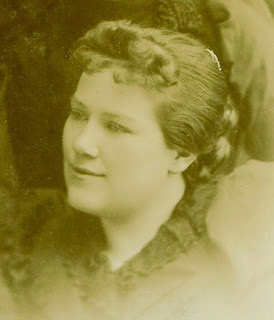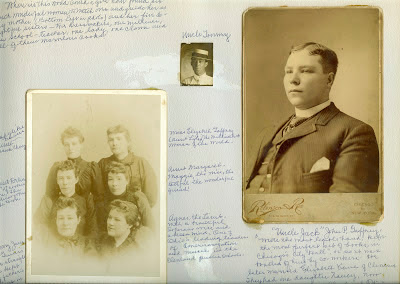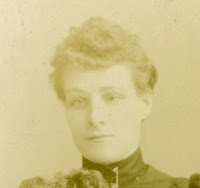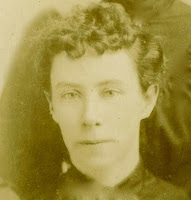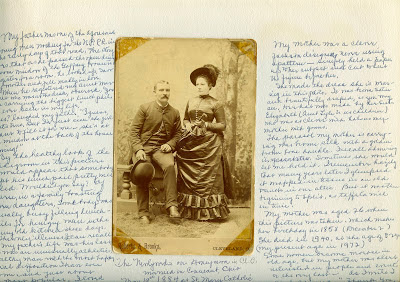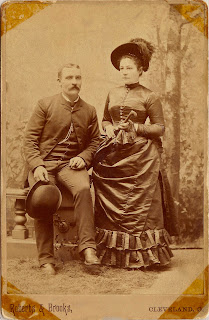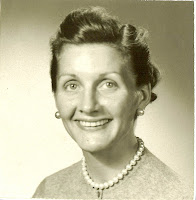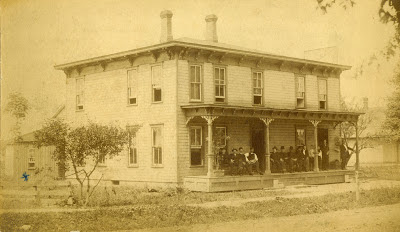Elizabeth “Lyle” Gaffney
(1862 – 1934)
 |
| Elizabeth “Lyle” Gaffney |
This picture of Elizabeth “Lyle” Gaffney is part of a group photograph of the six Gaffney sisters of Conneaut, Ohio. Born on May 16, 1862, Lyle was the second of the ten children of John and Bridget (Quinn) Gaffney.
She was the daughter of hard-w0rking Irish immigrants who risked everything to come to America some years before. They had overcome their share of obstacles to establish themselves on the Ohio frontier, own a home, start a business, and support a large family. The children in turn, grew up helping their parents with the daily chores of running a large boarding house.
Like her sisters, Lyle learned to sew at the feet of her mother, Bridget. Early in life, she discovered she had a talent for designing and making hats. Her designs were so popular in Conneaut that she opened her own millinery shop. This was quite an accomplishment for a spinster, as an unmarried woman was called in those days.
Most women married and had children during this time, and having a job or a career was typically not viewed as an appropriate thing for a woman to do. There were, however, some exceptions.
Millinery work was a respected field for women, and 19th century society placed no obstacles on it as a career. The primary clients of a millinery shop were women, after all. A milliner was expected to know the latest fashions; often many shop owners traveled to New York, Philadelphia, Boston, and even Europe to stay abreast of the newest styles, colors, and fabrics.
Milliners were in effect entrepreneurs, and they were constantly on the lookout for inventory that would keep their customers well dressed and happy. Their merchandise consisted of not only fine hats and bonnets but also accessories, such as handbags, gloves, fabric, small gifts, and jewelry. Many shops even carried selections of clothing. Lyle’s dressmaking sisters, Mary Jane and Margaret Gaffney, may have even consigned their designs to her store. With so many possibilities, it makes sense that the word “millinery” is derived from the Latin “mille,” or one thousand.
As with many trades, milliners learned their craft by apprenticing. When Lyle was about 18, she went to live with Hubert and Genevra Hotchkis at 98 Main Street in Conneaut Village, just across the river from her own family home. Hubert, 44, was a drugstore clerk, while Genevra, 33, was a clerk and a milliner. The 1880 United States Federal Census indicates that they had no children of their own, but it does show that they had a young male farmworker, a male boarder, and five other young female apprentices besides Lyle living with them at the time. Like Lyle, the young women were listed as servants.
Two of the apprentices happened to be Lyle’s maternal cousins, 20-year-old Annie Quinn and 17-year-old Mary Tinney.
Lyle is listed on this census as Eliza, short of course for her given name, Elizabeth.
She seems to have done fairly well for herself, even moving out of the immediate area for t time. There is an Elizabeth Gaffney, age 35, listed in the 1900 Federal Census, living in the town of Westfield in New York State. Westfield is about 60 miles northeast of Conneaut, so it is not too far out of the way to be implausible that this could be our Lyle.
The census goes on to note that Elizabeth Gaffney was born in Ohio and her parents are from Ireland. She works as a milliner and is the head of a two-person household. The other person living in the house is an 18-year-old woman named Jessie Maginnis, also from Ohio. The only question mark is why Jessie is said to be Elizabeth’s sister, as there were no Gaffney sisters by that name.
Knowing the extended family tree, we find that there is a possible explanation. Lyle’s older sister, Mary Jane, married someone by the name of McGinnis – Thomas Eugene McGinnis, specifically. Thomas had a niece named Jessie McGinnis who was born in the same year as the Jessie Maginnis in the census and also was from Ohio. If these two are who I believe them to be, then could Lyle have been apprenticing Jessie, her young niece-by-marriage? Would it have been easier to refer to her as a sister when talking to the census taker than to explain the complicated relation? I wonder.
It is hard to know how long Lyle lived in Westfield, as we do not have any information for the 20 year period between 1880 and 1900, census or otherwise.
Lyle eventually returned to Ohio, this time to Cleveland. In 1910, at 45 years old, she and her cousin Mary Tinney rented rooms from William Hupertz, a tailor. Family lore says that she opened her own millinery shop sometime afterwards. She became well known in the area for her elegant hats and counted a number of distinguished clients, among them Annie Sullivan (Helen Keller’s teacher), who wore her hats; and the Henry Ford family, for whose children she designed baby bonnets.
 |
Elizabeth Gaffney, also known as Lyle, in center.
Is she surrounded by other milliners, or some of
her fun-loving customers? |
Lyle moved to Chicago in the late 1920s, to help her sister, Mary Jane (Gaffney) McGinnis, who had been widowed in 1927. Her spunk and sense of humor did wonders for my great-grandmother, who was quite distraught at the loss of her husband, Thomas. During that period, Marshall Field Department Store hired Lyle as its chief milliner.
In about 1930, my mother, Joan Schiavon, came to live with her maternal grandmother Mary Jane, during the Great Depression. Mary Jane and Lyle spoiled my mother, making her beautiful bonnets and dresses. Together they even made her an elaborate ermine fur coat. From family reports, the coat was unusual, to say the least, in the middle of the austere Depression.
Like many in the Gaffney family, Lyle suffered from heart disease. In failing health, she retired and returned to the family home in Cleveland, Ohio, with her sisters, Agnes and Delia. Her condition worsened, and she died on October 3, 1934, at the family home on 17813 Woodbury Avenue in Cleveland, ohio, of angina, or coronary heart disease.
Lyle made a big impression on my mother, who was 6 years old when her great-aunt died. She regarded Lyle as her favorite aunt and adored her such that she gave me my middle name, Elizabeth, after her. Based on the love my mother had for this sweet lady, I’m glad she did.
**********
Copyright © 2013 Linda Huesca Tully
Like this:
Like Loading...
